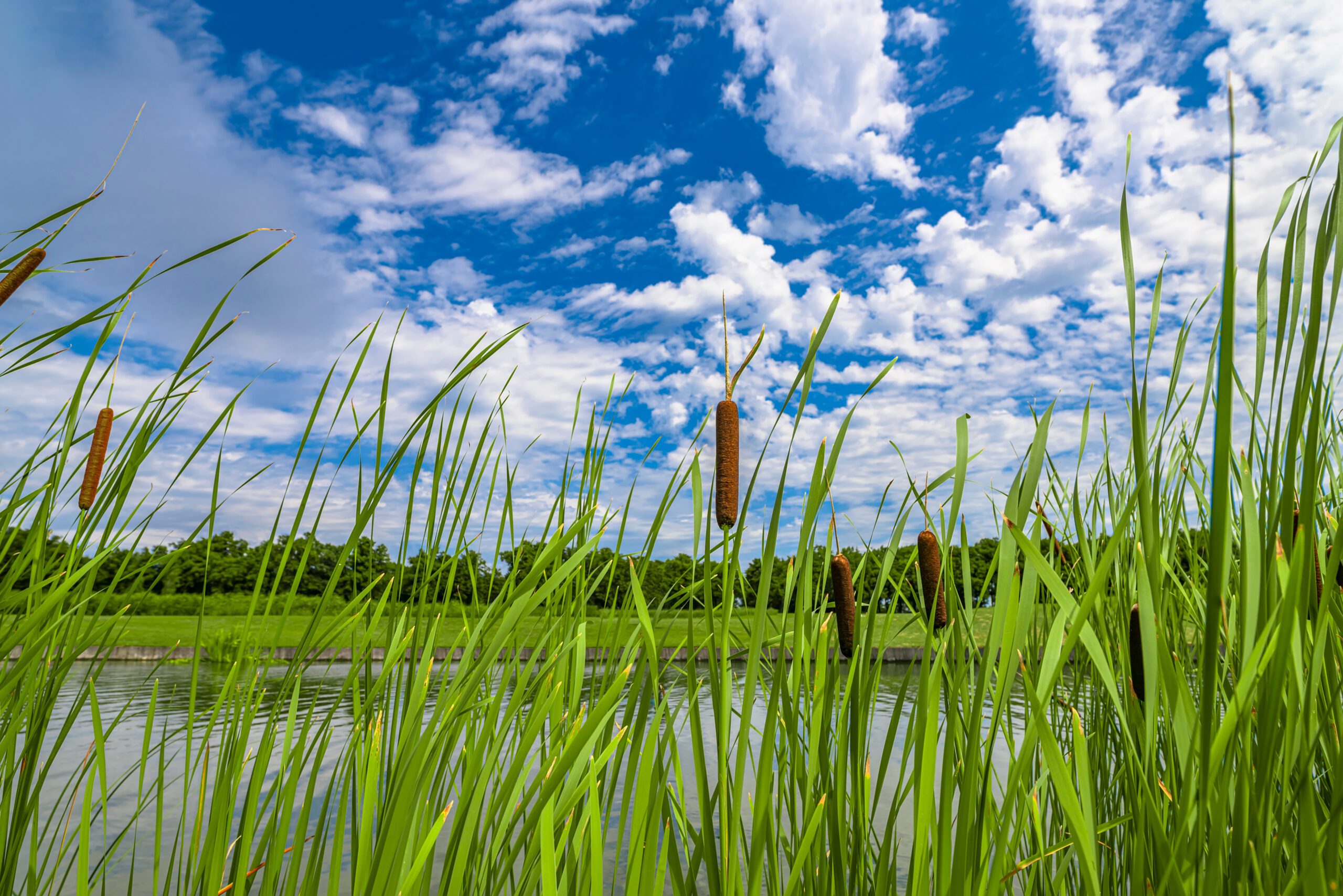Got Cattails? Landscape Architecture and Sustainable Design

Introduction to Landscaping
When many think of landscape design, they picture inviting flower beds, shrubs neatly arranged around a yard, or a personal garden. However, landscape architecture is an art that goes beyond aesthetics, it has the power to create harmonious and sustainable environments, whether that be within a neighborhood or a bustling city center. In the pursuit of sustainable design, professionals in our field are increasingly turning to natural elements to enhance their projects.
BHC’s landscape design experts define how the world impacts us. Not only do they create spaces that are welcoming and visually stunning, they also improve overall mental health and promote vegetation that has a positive influence on our communities and residents. Designers consider how people will use the space and incorporate elements that promote accessibility, circulation, safety, and functionality. The proper integration of these elements is paramount to success, and they include flora, water features, hardscaping (paths, walls, and structures), lighting, and furniture. The more welcoming and functional the space, the more people that will visit the area. Depending on the site, this could even have economic benefits and increase foot traffic, take the Country Club Plaza in Kansas City, for example.
Another example of the profound impact of landscaping is its use within healthcare projects, like the project BHC completed at Saint Luke’s Rehab Institute. Their therapy garden provided a beautiful environment for patients to regain strength and confidence. Through strategic plantings, we enhanced the patients’ connection to nature and eased the healing process by creating a calming and empowering space.
We know plants generate oxygen for us to breathe, kind of important, but did you know plant species like cattails can filter water and protect against soil erosion? This is just one of the many benefits to be gained from the strategic planting of this type of vegetation. Cattails, often found near bodies of water, possess remarkable environmental benefits, and offer several opportunities for incorporating principles of sustainable design.
Why Cattails?
Imagine you had a pond on your property, oh what a perfect home, it’s not everyone’s dream but bear with me for the sake of the example. I’ll be quick! There’s nothing around, no tall grass, just green, flat land with a big ol’ sparkling pond in the middle of it. Sounds nice, right? Well, without any cattails or vegetation around, the banks would quickly erode, washing sediment into the water and making a mess of the slope. This would inevitably cloud the water, disrupt wildlife habitats, and skew the balance of nutrients in the pond. However, through the use of cattails and other hydrophytic plants (water-loving or especially suited for growing in low-oxygen environments), we can promote healthy aquatic habitats and keep the water clear.
In the landscape architecture world, the question “Why?” is often asked when referring to green or environmentally positive efforts. It’s common for clients to focus more on the functionality and benefits of the site itself rather than the landscaping. Oftentimes the “easy” choices are the ones with minimal maintenance and immediate benefit. However, these “easy” decisions are often invasive or detrimental to the surrounding habitats.
Benefits
There is a common misconception that “all cattails are bad.” This is false because, while they are dense and fast-growing plants, they strengthen ecosystems and only become a nuisance if not managed properly. And to be fair, all plants must be maintained to a degree, whether that be watering, trimming, weeding, etc. Cattails and other hydrophytes provide several benefits to wetland habitats, including water filtration, habitat creation, and erosion control. Landscape architects make it a point to include best management practices (BMPs) in their designs, and their vast knowledge of natural elements can help engineers to achieve the most effective results while preserving natural resources.
Cattails can act as natural filters, absorbing excess nutrients, sediments, and even pollutants. Their large root systems and dense growth help in absorbing heavy metals and toxins from soil and bodies of water. As engineers and landscape designers work together to design water management systems, this vegetation improves the quality of stormwater before it’s returned to our natural water sources. This low impact design can promote a healthier population while also keeping the surrounding environments thriving.
Bodies of water, specifically those with dense foliage on the banks, provide habitats for various species of birds, insects, amphibians, and small mammals. The cattail stalks offer nesting sites, shelter, and food sources, contributing to the biodiversity of wetlands and aquatic ecosystems.
The robust roots of cattails also help to stabilize soil and prevent erosion along the water’s edge. They reduce the impact of waves and currents, protecting shorelines from degradation and keeping habitats flourishing. Effective stormwater management will reduce and prevent flooding at a particular site, protecting local properties and lives. Highly functional and low-impact designs also pose a higher chance for plan approval, simplifying the process for clients.
Uses in Sustainable Design
We spoke about the additional aesthetic benefits, like those associated with the Rehab Institute, but what about the sustainable aspects, and how they could be used within normal developments? I’m glad you asked. Landscape architects have extensive experience not only with landscape design but managing stormwater as well. These two concepts go hand-in-hand when it comes to sustainability.
A majority of site design projects require stormwater management such as rain gardens, detention basins, and stormwater swales. All ways in which our designers can manipulate the soil to aid in the management of stormwater without drastically impacting the land. The development of Lenexa Hills Elementary, for example, contained both a rain garden and overflow swales. These gardens are designed to capture and filter stormwater runoff, do you remember which plants make excellent natural filters? By planting cattails and native grasses in these areas, landscape architects can enhance water quality and minimize the impact of urban runoff on nearby bodies of water. Swales serve a similar purpose, slowing stormwater that may otherwise be damaging to the environment. They also spread this runoff across the landscape at a slower rate as to avoid flooding or water reaching the roads. This flow across a swale can prevent storm sewers from becoming overwhelmed, and effectively manage the amount of stormwater that the system has to redirect. This practice can keep the public safe from flooding while also putting the water to use.
As stated previously, cattails and other hydrophytes such as yellow iris, marsh milkweed, and Joe Pye weed excel at filtering toxins and pollutants from bodies of water, thus becoming excellent rehabilitators. If they are used at contaminated or polluted sites, they can improve environmental conditions and promote ecological recovery within the habitat/ecosystem. Controlling and managing plants in an aquatic setting can prove challenging, but there are ways to control these species while reaping their benefits. Organic efforts have the greatest effect whereas herbicides will have a negative impact on water quality. A few organic practices include root barriers or lined ponds for strategic planting.
Wrap-up
Landscape architecture plays a vital role in promoting sustainability by creating harmonious and resilient environments that benefit both humans and the natural world. As our planet faces numerous environmental challenges, BHC’s experts are working hard with engineers to reach unique solutions when it comes to site design. This type of collaboration has inspired many to incorporate green practices into engineering design, preserving natural resources, and uncovering innovative ways to continue improving communities.
These principles and designs promote social well-being by creating inclusive and accessible spaces that foster community engagement and a connection with nature. By incorporating green spaces, pedestrian-friendly designs, and active transportation infrastructure, landscape architects can improve the quality of life, physical health, and mental well-being of individuals. In short, sustainable landscape architecture is not just about aesthetics or functionality but protecting and enhancing the natural environment for present and future generations. Check out our other articles surrounding landscape design and stormwater at ibhc.com/article/stormwater-bmp-starts-with-good-design/.
Interested in learning more about incorporating sustainable design into your next project? Connect with one of our knowledgeable experts today at ibhc.com/connect.
